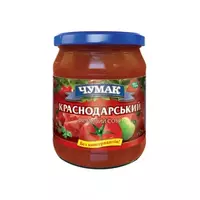Krasnodar sauce

Tomato sauces have become an integral attribute of the tradition of modern global cooking. Today, many varieties of tomato sauces stand out, as a rule, differing in composition, taste and nutritional value. For example, even a simple tomato sauce can perfectly emphasize the taste and aroma of the finished dish. Most often, various types of tomato sauces are used as a savory accompaniment for dishes made of meat, poultry, fish or vegetables.
Surely, many compatriots remember a very popular and, moreover, especially inexpensive sauce, which was sold in half-liter glass jars. It filled numerous shelves of empty stores during the USSR. We are talking about Krasnodar sauce, which is still popular today.
The slightly insular and at the same time savoury taste of a real Krasnodar sauce is perhaps difficult to compare with modern ketchups. Krasnodar sauce is used by hostesses when preparing many meals - it can be added to the first dishes (for example, borscht), pizza, casseroles, stewed vegetables, sandwiches and sandwiches. The calorie content of Krasnodar sauce, made according to traditional technology, averages 141 kcal.
Composition of Krasnodar sauce
Many people who are scrupulous about their health are always interested in the composition of an industrial product. So, the composition of the Krasnodar sauce, which is made in accordance with GOST 50 903-96, contains such ingredients as tomato paste, sugar, salt and apple puree.
In addition, the product sterilized and packed by hot pouring is trimmed with hammered cloves, cinnamon, allspice, nutmeg, garlic and black hot pepper. Acetic acid is used as a regulator of acidity in the Krasnodar sauce.
Due to the fact that recently more and more producers, trying to significantly reduce the cost of making products, various food additives can increasingly be found in food products. Often, along with natural colors, flavors, preservatives, synthetic analogues are also used, which subsequently adversely affects human health. That is why a lot of culinary experts prefer homemade preparations - they also cook Krasnodar sauce on their own.
In fact, the preparation of Krasnodar sauce is not much different from the method of cooking another type of this product. The only difference is observed only in the composition of this additive - in this case, apple puree is used, which makes Krasnodar sauce softer in taste and pleasantly shades tomato notes. Homemade apple puree from fresh fruits is prepared in a similar way to raw tomato-based puree.
Krasnodar sauce 141 kKal
Energy value of Krasnodar sauce (Ratio of proteins, fats, carbohydrates - ju):
Proteins: 0.6 g (~ 2 kCal)
Fats: 0.17 g (~ 2 kCal)
Carbohydrates: 19.2 g (~ 77 kCal)
Energy ratio (bj | y): 2% | 1% | 54%
 Español
Español Français
Français Português
Português Русский
Русский 简体中文
简体中文 繁體中文
繁體中文 日本語
日本語 한국어
한국어 العربية
العربية Türkçe
Türkçe Қазақ
Қазақ Deutsch
Deutsch Italiano
Italiano Українська
Українська
